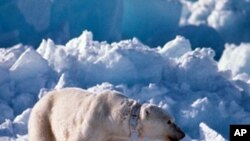The United States is stepping up its efforts to protect polar bears threatened by the loss of their habitats. On November 23rd, the Department of the Interior's Fish and Wildlife Service designated more than 187,000 square miles [484,327 kilometers] of barrier islands, on-shore denning areas, and off-shore sea-ice as critical habitat for endangered polar bears.
The designation identifies geographic areas containing features considered essential for the conservation of the bear that requires special management or protection.
"This critical habitat designation enables us to work with federal partners to ensure their actions within its boundaries do not harm polar bear populations," said Tom Strickland, Assistant Secretary for Fish and Wildlife and Parks. "Nevertheless, the greatest threat to the polar bear is the melting of its sea ice habitat caused by human-induced climate change," he said. "We will continue to work toward comprehensive strategies for the long-term survival of this iconic species."
The designation encompasses three areas or units: barrier island habitat, sea ice habitat and terrestrial denning habitat. Barrier island habitat includes coastal barrier islands and spits along Alaska's coast, and is used for denning, refuge from human disturbances, access to maternal dens and feeding habitat along the coast. Sea ice habitat is located over the continental shelf, and includes ice over water up to three hundred meters in depth extending to the outer limits of the U.S. Exclusive Economic Zone, 321 kilometers from shore.
Terrestrial denning habitat includes lands within 32 kilometers of the northern coast of Alaska between the Canadian border and the Kavik River and within 8 kilometers between the Kavik River and Barrow, Alaska. Approximately 96 percent of the area designated as critical habitat is sea ice habitat.
The U.S. designated the polar bear as an endangered species on May 15, 2008, due to loss of sea ice habitat caused by climate change. Polar bears are completely dependent upon Arctic sea-ice habitat for their survival. The United States is committed to protecting this endangered species and the habitat that sustains it.
Protecting Polar Bears

More than 187,000 square miles [484,327 kilometers] of barrier islands, on-shore denning areas, and off-shore sea-ice has been designated as critical habitat for endangered polar bears.
















